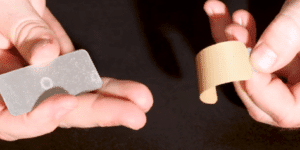When you are thinking about ordering custom metal nameplates, you might think about what material you want, the thickness, or even the process. What you might be forgetting is how you are going to attach your nameplates.
Adhesive backing provides a quick and long-lasting way to easily attach your nameplates to nearly any surface.
Attaching Metal Nameplate
In short, there are many different ways to attach your metal name plates. There really is no one standard or best way.
One of the most common attachment methods is using screws or bolts to mount the nameplate. Keep in mind the nameplates will need to have holes added to them in order to bolt them on.
Another way metal nameplates are often placed is by hanging them from a wire or chain. This is very common for valve nameplates and similar applications.
For cable ties, no additional mounting hardware is required as they wrap around a cable, pipe, or wire. The tail end slips through a hole in the nameplate and bends, creating a connected ring.
In addition to mounting, metal nameplates are sometimes even welded on.
While these options have their purposes, the most popular choice for metal nameplate attachment is using adhesive backing.
Why Use Adhesive?
Ease of Use
Ever try to place a nameplate in a hard-to-reach location? Screws and wires can be a source of frustration. This is where having an adhesive backing can be a lifesaver as a quick application also means less of a headache.
In comparison to other methods, adhesives are incredibly easy to apply. If you’ve ever put a sticker on something, you’re already experienced. It really is as simple as peeling off the backing and pressing the nameplate against the surface. It’s really that easy.
The metal nameplates fit perfectly flat against the surface, and 24-48 hours after application are set.
Not only does this save a ton of time and headache. This also allows for anyone to affix the metal labels. In addition, it also eliminates the need to buy screws, wires, or bolts. Plus, the nameplates don’t need holes, freeing up more real estate for your design.

Long Lasting
With industrial grade adhesive you are getting a long lasting solution. Your industrial metal nameplates will stay attached for a significant amount of time. This time frame will vary based on the adhesive used, environmental conditions, etc.
Versatility
It is able to attach nameplates to a wide range of surfaces. It is also compatible with a wide range of nameplate materials.
Including:
- Aluminum
- Stainless Steel
- Brass
- Copper
- And More!
Types of Adhesive
There are as many types of adhesive as you could possibly imagine.
The trick is to find the one that is best for your industry or application.
For most industrial applications, you want a high strength adhesive that is formulated specifically for industrial use.
These adhesives are not like the ones you use in elementary school art class. In short, they are called industrial grade for a reason. They are made to semi-permanently adhere to metal substrates and similar surfaces.
Industry use means the backing will be exposed to all sorts of conditions. This includes weathering, chemicals, varying temperatures, and more.
Note: The specs for each type of adhesive vary. Some are better suited than others for tough conditions.
If you know the environment your ID plates are going to be exposed to, it makes figuring out the right adhesive significantly easier. Make sure you specify this when working with your manufacturing on your next metal nameplate project.
Limitations/Drawbacks
Process Limitations
One of the big drawbacks to using adhesives is that they cannot be applied to every type of metal nameplate.
This primarily affects the embossing and stamping processes. By applying the adhesive, the nameplates can no longer be put into a press to run, which creates additional processing and accompanying costs.
Flat Surfaces
Another potential issue is that these nameplates are primarily for flat surfaces. A rounded pipe or a bent surface may not provide sufficient adhesion. There are also exceptions, as using a very thin material which is more flexible might provide the right hold for your surface.
It is also recommended that the surface be as dry and clean as possible for best results.
Additional Cost
While this is typically factored into the price you are offered, keep in mind that adding an adhesive backing will add cost to your nameplates. It involves additional processes and time, plus the cost of the backing itself.
Wrap-Up
To summarize, adhesive backings are a great solution for applying your metal identification products. Industrial strength means your nameplates will stay attached even in tough conditions. If you don’t need an adhesive quite that strong, there are plenty of options to fit your needs.
No matter your application, there is an adhesive back solution that fits perfectly.